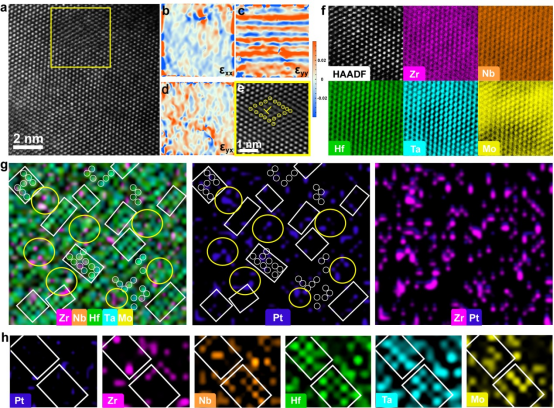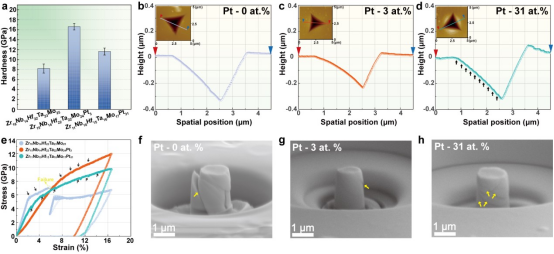Prof. Weitao Zheng’s Team at the School of Materials Science and Engineering of Jilin University has recently made important progress in the field of high-entropy alloys (HEAs) by synthesizing a new form in HEA family, paracrystalline HEA, which consists entirely of crystalline medium-range ordered (MRO) structures (as paracrystalline basic units). Such a novel HEA nanostructure both strengthens the alloy substantially and opens up near-homogeneous plastic deformation behavior. The research results, titled "Pt-induced atomic-level tailoring towards paracrystalline high-entropy alloy," were published online on Feb. 11, 2023, in Nature Communications.
HE-MGs (high entropy metallic glasses), as same as traditional MGs, always suffer from catastrophic failure because the plastic deformation highly concentrates on the single shear band (SB). As a promising strategy, introducing the crystalline medium-range order (MRO) into MGs plays a significant role in the homogeneous plastic flow, instead of the undesirable failure in form of a dominate SB, as the length scale of MRO is comparable with the shear transformation zones (STZs) carrying plastic flows in MGs. Interestingly, a state with neither crystalline nor amorphous states called paracrystalline state, which is fully stacked with crystalline MRO mingled with a little disordered matrix, has been recently synthesized in the diamond system. Inspired by such a paracrystalline state in the covalent material system, it is promising to explore the paracrystalline state in metallic materials which may make full use of the aforementioned merits of crystalline MRO in MGs. However, under thermodynamic control, it is difficult to achieve the uniform and size-controllable precipitation of crystalline phase in MGs because of the complexity of crystallization processes, particularly for a paracrystalline state. Fabricating paracrystalline metallic materials is still facing huge challenges. To address this challenge, Prof. Mao Wen and Prof. Kan Zhang in Weitao Zheng’s Team have proposed a new synthetic method for the preparation of paracrystalline high entropy alloys to achieve artificial modulation of the crystalline MRO structure of the high entropy family, providing more possibilities for mechanical optimization.
In this work, the severe-lattice-distorted crystalline Zr-Nb-Hf-Ta-Mo HEA is chosen as the base system; subsequently, utilizing the growth characteristics of co-sputtering, a typical “layer-by-layer” model based on “down-up” strategy, the high-negative-enthalpy foreign Pt atoms are continuously and uniformly introduced into growth front of Zr-Nb-Hf-Ta-Mo HEA, ensuring these Pt atoms atomically dispersed in the HEA lattice sites. The atomic-level intracrystalline Pt atoms may disturb the coordination of surrounding atoms and form favorable Pt-Zr pair due to its ΔHmix up to -100 kJ/mol, further triggering local disorder surrounding Pt atoms when the highly negative enthalpy encounters with inherent severe lattice distortion. As a result, based on an enthalpy-guided strategy, Pt-Zr-enriched amorphous groups surrounding foreign Pt atoms successfully separate severe-lattice-distorted Zr-Nb-Hf-Ta-Mo grains into crystalline MRO, forming the paracrystalline HEA. The atomic-scale tailoring strategy of "high negative mixing enthalpy + severe lattice distortion" contributes to the simultaneous heterogeneous regulation of structural topology and chemical grouping at the sub-nanometer scale, which tuning the transition group heavy metal HEA with ordered structural topology into a novel HEA structure with sub-nanometer-scale paracrystals as a structural unit. Such a paracrystalline nanostructure bridges the gap between nanocrystalline and amorphous materials, suppressing the dislocation behavior of crystalline materials and avoiding the strong local shear deformation behavior of amorphous materials during the loading process, and enabling the material to achieve homogeneous plastic flow at the macroscopic scale. While doubling the hardness and compressive strength by 69.2%, the ultimate plastic deformation is significantly increased, providing a new design idea for the design of strong and tough integrated high entropy alloys. With a 100% and 69.2% increase in hardness and compressive strength, respectively, the limit plastic deformation is significantly increased, which provides a fruitful “menu option” for the design of HEA with strength-toughness synergy.


